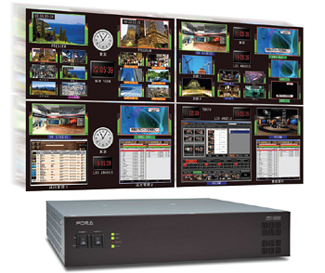Multiviewers Push Monitoring Envelope

For-A's 3200 multiviewer
OTTAWA
Video walls are becoming standard equipment in master control rooms and OB trucks, and flat panel LCD and plasma monitors are the displays of choice. In tandem with multiviewers, modern video walls let producers view multiple video windows on one or more very large flat panel displays.
"This [technology] starts to put into one box what used to take multiple boxes to do," says Mike Garrido, product manager for Harris' multiviewer products. "As a result, systems are simpler to maintain, as well as using less space and power. Adding items like virtual network connections, for example, allows for the control [not just viewing] of many devices from one central location. Now the user can interact with servers, cameras and PC's from one screen thereby being more effective in their daily work."
CURRENT STATE OF THE ART
Today's video wall/multiviewer combinations, are really intelligent signal processing systems. These digital signal processors have capabilities not imagined in the days of analog TV.
One such capability is the incorporation of a built-in routing switcher in the multiviewer, according to Thomas Tang, president of Apantac, a Portland, Ore.-based provider of multivierwers. "This allows the multiviewer to drive multiple displays while sharing the sources." A second is field "upgradability" to 3Gbps/1080p. This means that a station/network video display system can "be upgraded with firmware or software without taking the system out of operation," Tang said.
Video wall/multiviewers also let producers "change a monitor wall view on the fly, without having to physically unbolt monitors from racks," said Louis Caron, multiviewer product manager for Miranda Technologies in Montreal. "With the latest generation multiviewers, the quality is now very high, and users can monitor a much wider array of broadcast functions, including the analysis of video/audio signals so operators can make critical judgment calls quickly."
That's not all: "The move to support larger numbers of incoming feeds has pushed the technology to allow such advancements as software-generated display layouts," said Tom Yuhas, national sales director with For-A Corporation of America in Cypress, Calif. "In addition, the support of tally display, title display, time display, video loss detection, SNMP support and more are now making the multiviewer an important part of any video wall application."
DISPLAYS
Advances in monitor design have allowed TV manufacturers to reduce or even eliminate the bezel (the casing around the monitor edge). The result are LCD and plasma monitors that can be combined to create very large video walls; ideal not just for control rooms but eye-catching displays at trade shows. "We have used this in the New York Auto Show," says Evan Schechtman, CTO of Radical Media, a New York-based production company. "This [approach] is less expensive than LED walls, and renders fine images better."
Then there's 3DTV. "In the past, directors of stereoscopic 3D content have faced real challenges when managing cuts between camera pairs in order to avoid jarring changes in 3D perspective, especially in live environments," said Miranda's Caron. However, modern 3D multiviewers "allow multiple 3D cameras to be monitored simultaneously and easily in high quality stereoscopic 3D. This enables a director to view the perspective of all the cameras before choosing the next shot, and thereby overcome the issue of mismatching perspectives."
WHAT'S NEXT
Today's video wall/multiviewer combinations are powerful systems. But even more advanced capabilities are in the pipeline.

Miranda x16 3D multiviewer So what should TV engineers be watching for? "Detection of lip-sync error [audio /video delays], and the monitoring of compressed [MPEG]," Caron said. "Having control of other equipment [test and measurement, servers, other PCs] from the wall itself instead of having to go to another screen or workstation," added Garrido.
Yuhas expects video wall/multiviewer layout software to become more flexible, such that it can support "network video streaming and monitoring video wall functions over IP." Schectman says he's on the lookout for "laser-based displays, and super bright short-throw projection systems."
Flat panel video walls and multiviewers can be found in large TV stations and networks. But what about small stations: Is this technology within their budgetary grasp?
Yes, according to Louis Caron and Thomas Tang. "Virtual monitoring solutions are the most cost effective solution for smaller stations right now, and Miranda offers multiviewers that scale from very small to the largest of applications," said Caron. Multiviewers have become "the defacto standard for monitoring in facilities whether large or small, and are the most economical way to monitor input signals," says Tang.
Harris' Michael Garrido disagree and thinks that current prices are beyond the reach of small operators, "but give it a few years," he said. "As the technology advances and prices move downward, the need for smaller facilities to be more efficient will start to dominate," he says. "There will be a need for one person to do more; resulting in an increase in small to medium-sized [video] walls to be present, so more information is available to a handful of people."
Today's video wall/multiviewer combinations represent a tremendous leap forward in signal monitoring and control. They are to old-fashioned dedicated monitors, as computers are to abacuses, and likely to become as common in TV operations as cameras and lights.
The professional video industry's #1 source for news, trends and product and tech information. Sign up below.
James Careless is an award-winning journalist who has written for TV Technology since the 1990s. He has covered HDTV from the days of the six competing HDTV formats that led to the 1993 Grand Alliance, and onwards through ATSC 3.0 and OTT. He also writes for Radio World, along with other publications in aerospace, defense, public safety, streaming media, plus the amusement park industry for something different.

